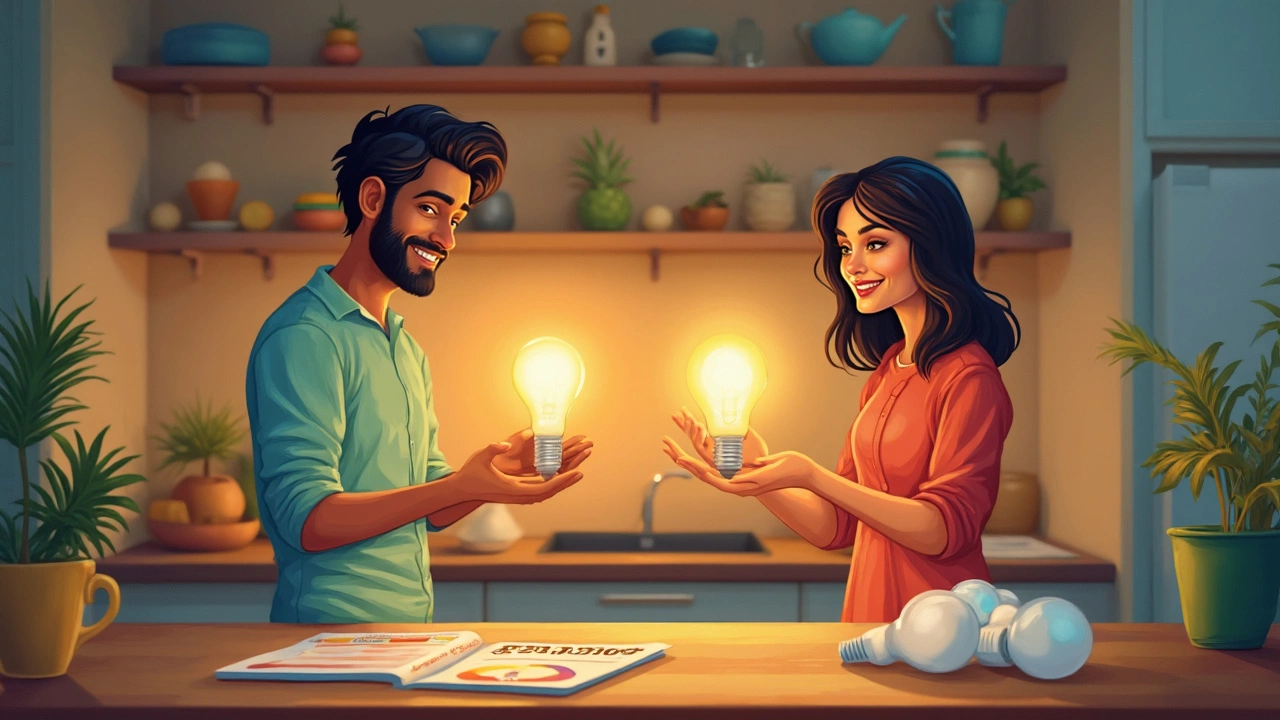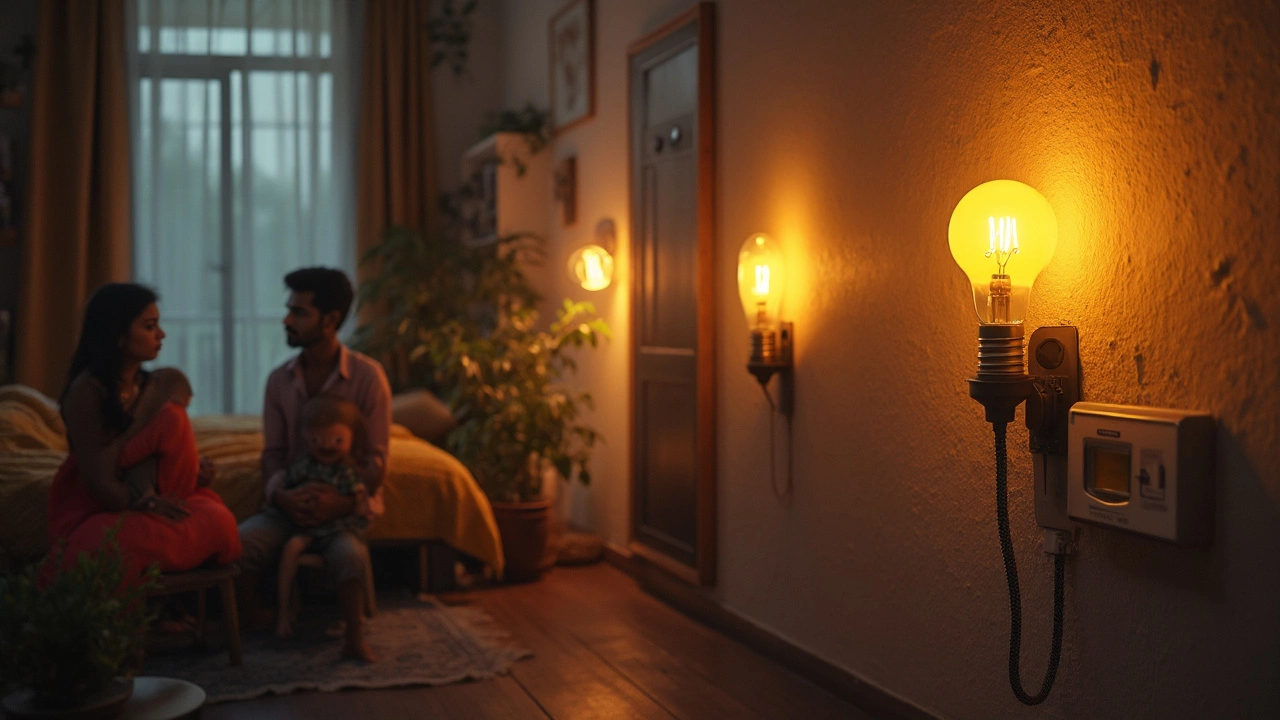Most people don’t realize how much money they waste on lighting until they make a switch. Lighting makes up about 15% of a typical home’s electricity use, and if you’re still rocking those old-school incandescent or halogen bulbs, you’re basically tossing cash out the window. There’s a better way, and thankfully, it doesn’t mean living in the dim light of a dungeon.
If you want the top pick for efficient home lighting right now, it’s LED bulbs—no contest. LEDs use about 75% less energy than incandescent bulbs and last up to 25 times longer. That means fewer trips to the hardware store and less junk going into landfills. Even the “second best” options, like CFLs, can’t quite keep up when you look at the numbers and lifespan.
But it’s not just about swapping bulbs. The type of light, where you put it, and even the color temperature can make a difference in how you feel and how much you spend. Ever noticed how glaring kitchen lights can almost give you a headache, or how a cozy lamp changes the vibe in the living room? Getting the right setup can actually help everyone in the house be more comfortable—and make Finnian finally stop complaining the hallway is too dark at night.
- Why Lighting Efficiency Matters
- Comparing Bulb Types: LEDs vs Others
- Room-by-Room Lighting Tips
- Smart Lighting and Bonus Money-Saving Hacks
Why Lighting Efficiency Matters
If you ever wonder why your electric bill is higher than expected, lighting probably plays a bigger role than you think. In the average U.S. home, lighting takes up about 15% of the total electricity budget. If you haven't jumped on the efficient home lighting bandwagon, you’re basically handing money to your utility company for nothing.
Swapping out old bulbs for efficient options saves cash and has a real impact on the environment. Less power used also means less pollution from power plants. The U.S. Department of Energy puts it this way:
"By replacing your home's five most frequently used light fixtures or bulbs with ones that have earned the ENERGY STAR, you can save $75 each year."
Not convinced yet? Here’s a quick breakdown comparing average annual electricity use for different bulb types in a 60-watt equivalent socket, running three hours a day:
| Bulb Type | Annual Cost (USD) | Lifespan (Hours) |
|---|---|---|
| Incandescent | $7.20 | 1,000 |
| CFL | $1.70 | 8,000 |
| LED | $1.20 | 25,000 |
That adds up fast, especially if you live in a place where every room has a light on most evenings. Besides the money, efficient lighting—especially LED bulbs—runs cooler, so your AC doesn’t have to work as hard in the summer. Even little changes make a difference if you add them up across your whole house.
- Lower bills: Less energy means less money spent every month.
- Less hassle: LED bulbs last years longer, so you change them far less often.
- Better for the planet: You shrink your carbon footprint by using less electricity and tossing fewer burnt-out bulbs in the trash.
So, making the switch to efficient lighting isn’t just about staying trendy—it’s a practical way to save money and do something good for the environment without really lifting a finger.
Comparing Bulb Types: LEDs vs Others
If you’re staring at the light bulb aisle and feeling lost, you’re not alone. So many choices, but not all bulbs are created equal. Let’s break down what matters most: cost to run, lifespan, and light quality.
First off, LED bulbs are the heavyweight champ for efficient home lighting. They use up to 75% less energy than classic incandescents. LEDs can last more than 15 years in a typical home setting—so if you put one in your kid’s room, you might not have to change it until they’re taller than you. They don’t get hot either, which means less wasted energy, and no more toasty lampshades.
Incandescent bulbs are basically the dinosaurs of the lighting world. Sure, they’re cheap up-front, but they guzzle electricity and burn out in less than a year of normal use. They’re getting harder to find since manufacturers are phasing them out for a reason.
CFLs (compact fluorescent lamps) were once the go-to after incandescents, but they’ve fallen behind. Yes, they use less energy and last longer than incandescents—on average around 8,000 hours. But they contain small bits of mercury, which means messing with recycling. Also, CFLs can flicker and take a couple of seconds to reach full brightness. Not a huge deal, but you notice it on groggy mornings.
- LED Bulbs: Most energy-saving and longest life. Slightly more expensive up-front, but save way more money over time.
- Incandescents: Cheap to buy, pricey to run. High on energy waste and frequent replacements.
- CFLs: In between LEDs and incandescents. Long life, but recycling can be tricky because of mercury.
- Halogen Bulbs: These are a type of incandescent, except a little more efficient. Still, they heat up fast and don’t match LEDs on any level.
To help you see the difference quickly, here’s a simple breakdown:
| Bulb Type | Average Lifespan (hours) | Energy Used (Watts) | Annual Cost (per bulb) |
|---|---|---|---|
| LED | 15,000 – 25,000 | 8 – 15 | $1.50 |
| CFL | 8,000 – 10,000 | 13 – 25 | $2.00 |
| Incandescent | 750 – 2,000 | 40 – 60 | $6.60 |
| Halogen | 1,000 – 3,000 | 29 – 43 | $5.50 |
When picking out energy saving bulbs, LEDs check every box—lower bills, way less hassle, much better for the planet, and you don’t end up with burned fingers or wasted money. If you want more control (like dimming), look for LEDs marked "dimmable" and you’re golden. Unless a room gets almost no use, making the switch is a no-brainer.

Room-by-Room Lighting Tips
Choosing the most efficient home lighting really depends on where you’re putting it. Not every room needs the same amount or type of light, and, honestly, one-size-fits-all just doesn’t work. Here’s how to get it right in each space.
- Kitchen: Go bright with LED bulbs—they turn on instantly and don’t get hot. Use warm white (about 3000K) for main lights so it feels inviting. Stick LEDs under cabinets for task lighting. If you cook at night, this cuts shadows and helps you avoid chopping off a finger.
- Living Room: Layer your lights. Main overhead lights should use dimmable LEDs so you can set the vibe. Use floor or table lamps with lower wattage bulbs (like 7-10 watt LEDs) for chill evenings. Position lights to avoid glare on the TV.
- Bedrooms: Go for soft, warm white (2700K) bulbs. Install LEDs in bedside lamps so you’re not blinded during midnight wakeups. Kids’ rooms, like Finnian’s, do well with a night light—grab a very low watt LED or motion-sensor light so it’s only on when someone actually gets out of bed.
- Bathrooms: Bright, natural light works best—aim for cool white LEDs (4000-5000K). Put LED lights around the mirror, not above, to cut down shadows on your face (super helpful for shaving or makeup).
- Hallways & Entryways: Use motion-sensor energy saving LEDs. These rarely-used spots eat up a surprising amount of power if the lights are left on all day. A 9W LED works fine for most small halls.
Here’s a quick look at typical energy saving and lifespan stats for bulbs you’ll use around the house:
| Bulb Type | Wattage Range | Estimated Lifespan | Annual Cost (per bulb) |
|---|---|---|---|
| LED | 6–12W | 15,000–25,000 hrs | $1–$2 |
| CFL | 13–20W | 8,000–10,000 hrs | $2–$3 |
| Incandescent | 40–100W | 750–2,000 hrs | $7–$14 |
If you want true energy saving, swap the old bulbs for LEDs in rooms you use most. Bonus: Your electric bill will start to drop, and you won’t be up on a stool changing bulbs all the time. Smart, right?
Smart Lighting and Bonus Money-Saving Hacks
Smart lighting isn’t just for tech geeks or people who want to show off to neighbors. It’s one of the easiest ways to crank up your efficient home lighting game while making your space more convenient. With smart bulbs or smart switches, you can control your lights from your phone or even with your voice. No more reaching for that awkward lamp switch behind the couch—just tell your smart assistant to handle it.
Here’s a wild stat: According to Energy Star, households that switch to all LEDs and use smart controls can cut their lighting energy use by up to 90%. That’s not just a few bucks—it adds up, especially if you live in a bigger place or forget to turn off lights. Smart tech lets you automate lights so they turn off when nobody’s around, set schedules for waking up gently, or create scenes for movie night (with zero effort).
- Install smart dimmers to adjust brightness: Lower light means lower energy use. Dimming an LED by 50% can save almost the same amount in energy.
- Use motion sensors in hallways, closets, and bathrooms. Lights only come on when needed—no more chasing Finnian because he left every light blazing down the hall.
- Set up timers for outdoor lights instead of leaving them on all night.
- Group your lights by room or activity, so you can flick off everything with one tap when heading out or going to bed.
If you want bonus savings on energy saving, don’t ignore simple habits. Clean your light fixtures and bulbs every few months—dirt can block up to 50% of the light you’re paying for. And for rooms with lots of sunlight, just turn off the lights during the day and let the free light do its job.
| Lighting Option | Estimated Annual Cost (per bulb) | Average Lifespan |
|---|---|---|
| Incandescent | $8.50 | 1,000 hours |
| Compact Fluorescent (CFL) | $2.00 | 8,000 hours |
| LED | $1.20 | 25,000 hours |
If you’re serious about smarter home lighting, start small. Try a smart bulb in the room you use most, then add more as you get used to the perks. Before you know it, you’ll wonder how you survived flipping switches the old way—and your electric bill will show you’re not just being fancy, but actually saving real money.
